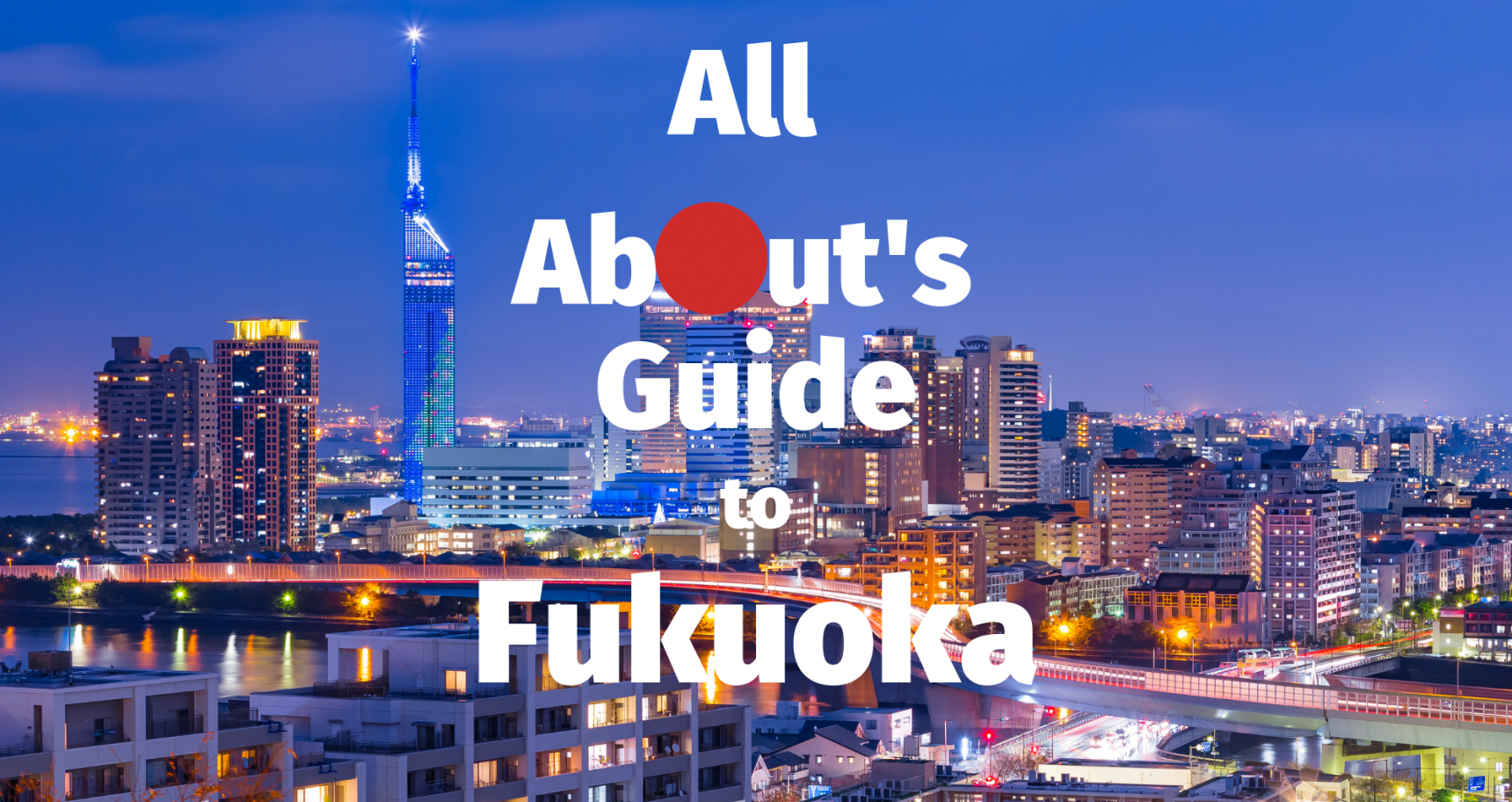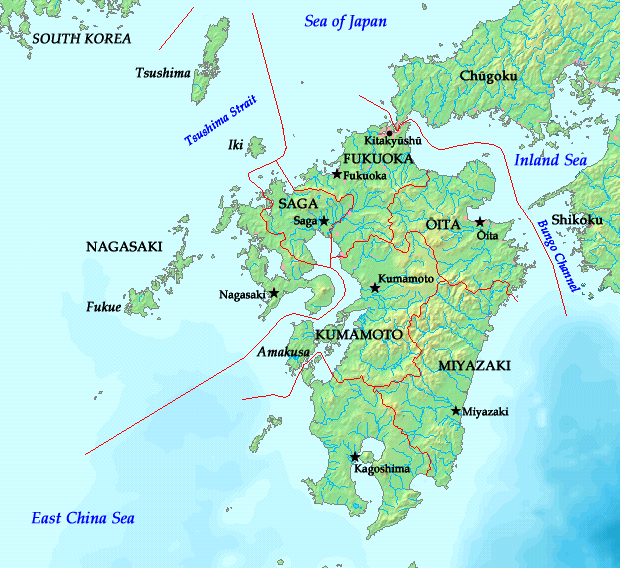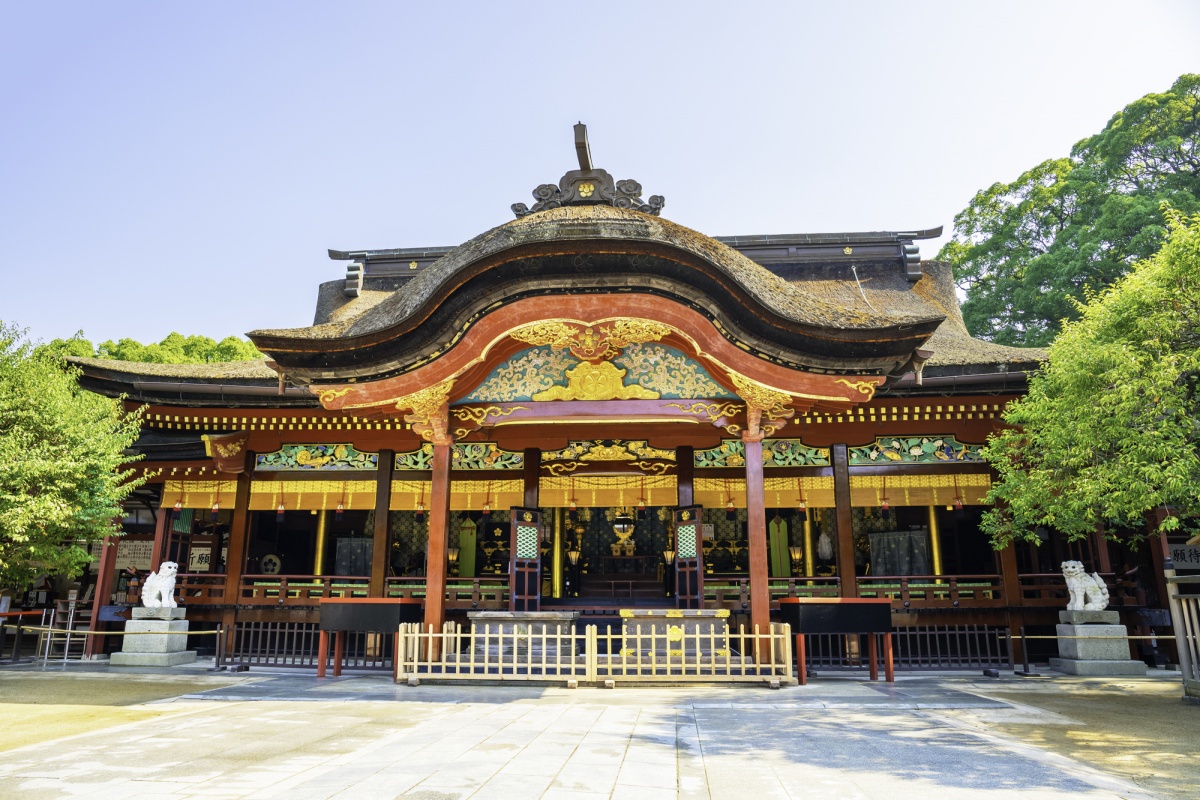All About's Guide to Fukuoka
Fukuoka is slowly become one of Japan's major metropolitan areas. It's a growing city that's rich in historical culture, has a thriving contemporary art scene, is swimming in top-notch ramen shops and provides some of the best pockets of inner-city nature in the country. So let's find out all about Fukuoka!
By DavidFukuoka Key Facts

The city of Fukuoka (福岡市) is the capital of Fukuoka Prefecture on the northern coast of Kyushu—the most westerly of Japan's four major islands. The city is the most populous in Kyushu, and sixth most populous in Japan, with some 2.5 million people occupying the greater metropolitan area. It serves as one of the islands major centers of culture, art, food, tourism, business and commerce. However, Fukuoka's journey to get to where it is today was an often perilous one, fraught with more than a few dangers and crushing setbacks. Let's see where it all began...
Rough Beginnings
Before Fukuoka came to be, the area was used as a frequent point of entry—or attempted point of entry—for Chinese and Korean invaders. Just 70 miles from the Korean peninsula, Kyushu's northern tip was somewhat of a conduit for continental influences. This was particularly evident during the years of the Chinese Han Dynasty (206 B.C. - 220 A.D.) when Japan's neighbors to the west was controlled by one of the world's greatest imperial regimes. Kyushu remained on the radar of Asia's largest conquering empire well into the next millennium.
Much later in the 13th century the gargantuan Mongol Empire led by Kublai Khan showed considerable interest in the Fukuoka area as well, with a barrage of invasions from 1274 through 1281. The latter of these was serendipitously halted by the kamikaze (神風) or "Divine Wind." In spite of their good fortune, the Japanese realised that the need for a bastion of defence in northern Kyushu was painfully evident.
A City Emerges
While Fukuoka's coastal defenses were gradually improved, the initial signs of the city of Fukuoka that we know today did not appear until considerably later. After fluctuating periods of war and peace over the centuries, the country was eventually unified under the shogun, Tokugawa Ieyasu following the Battle of Sekigahara. Shortly after, in 1601, feudal lord Chikusen Nagamasu started construction of a castle in northern Kyushu—Fukuoka Castle—which would signify the beginnings of new a city that was soon to emerge. The castle's name was in honor of Nagamasu's relatively obscure place of birth, and the unfinished ruins can still be seen today.
Fukuoka gradually grew in size over the coming centuries, and on April 1, 1889, Fukuoka was officially recognized as a city after it merged with the old mercantile and port district of Hakata, to the east. It is the districts of "old" Fukuoka (now Tenjin) and Hakata that make up Fukuoka's two halves. They are more or less divided by the Naka River, which bisects the city filtering down towards Hakata Bay just off the city's northern coast.

https://en.wikipedia.org/wiki/World_War_II
As Japan started to industrialize, Fukuoka's favorable location as a port town and its abundance of natural resources—particularly coal—made it integral to Japanese security and growth. It became a fulcrum point for prosperity in Japan's western reaches.
Like many cities in Japan, the course of Fukuoka's history was irrevocably changed during World War II. On June 20, 1945, bombing attacks on Fukuoka led to the deaths of around 1,000 people, and destroyed much of the city in the process. It's a testament to the will and determination of the people of Fukuoka that it has become the energetic, 21st-century metropolis that it is today.
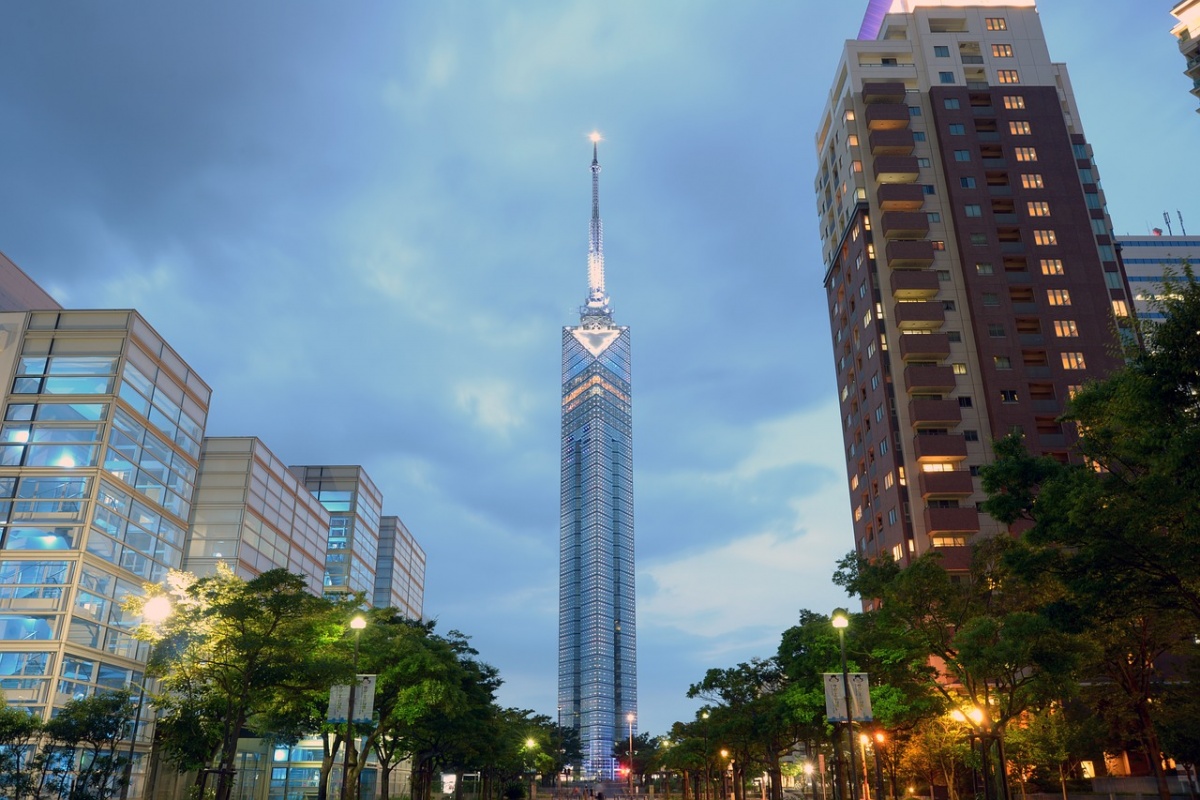
Nowadays Fukuoka is said to be Japan's fastest growing city. It seamlessly blends technological modernity with local historical culture, high-end boutique restaurants with tasty street food stalls and state-of-the-art shopping complexes with vintage clothing stores and shotengai market places. There's no lack of green space either as several large inner-city parks brighten up Fukuoka's towering, industrial visage. As they say "variety is the spice of life," and Fukuoka certainly has variety in abundance.
Top 5 Sights
There's enough to see and do in Fukuoka to keep you occupied for quite some time. Here's 5 of the best sights the city has to offer.
5. Indulge in Fukuoka's Art Scene
While technically not a single sight, one of the best things that you can (and absolutely should) do in Fukuoka is explore the local art scene. Museums, galleries, showrooms and creative abstract ideas all coalesce to form a thriving artistic culture that is very much at the core of what makes Fukuoka tick. Here are a few top recommendations;
・Mistubushi Jisho ARTIUM: ARTIUM is a pioneer among Kyushu's contemporary art and media galleries. The exhibitions—which change roughly every month—are displayed in the small, three-room gallery on the eighth floor of the Tenjin IMS building. The focus at ARTIUM is on contemporary artists that are local to the Fukuoka area.
Address: 1-7-11 Tenjin, Chuo-ku, 8F Ims, Fukuoka 810-0001
・Hiroki Oda Museum of Art: In the city outskirts, situated on a lush grassy plain and surrounded by mountains is the Hiroki Oda Museum of Art. The museum gets its name from local painter Hiroki Oda, who was as famous for his western style paintings as he was for his eccentric personality. The museum contains many of his original works and a quirky interior design that is said to be a fitting representation of Oda himself.
Address: 767 Kamiusui, Kama, Fukuoka 820-0502
・The Fukuoka Art Museum: The city's largest artistic outlet boasting works from local artists as well as the wider Japanese art community at large. And, it's in one of the city's prime locations on the banks of the pond at Ohori Park.
Address: 1-6 Ohorikoken Chuo-ku, Chuo 810-0051
4. Canal City
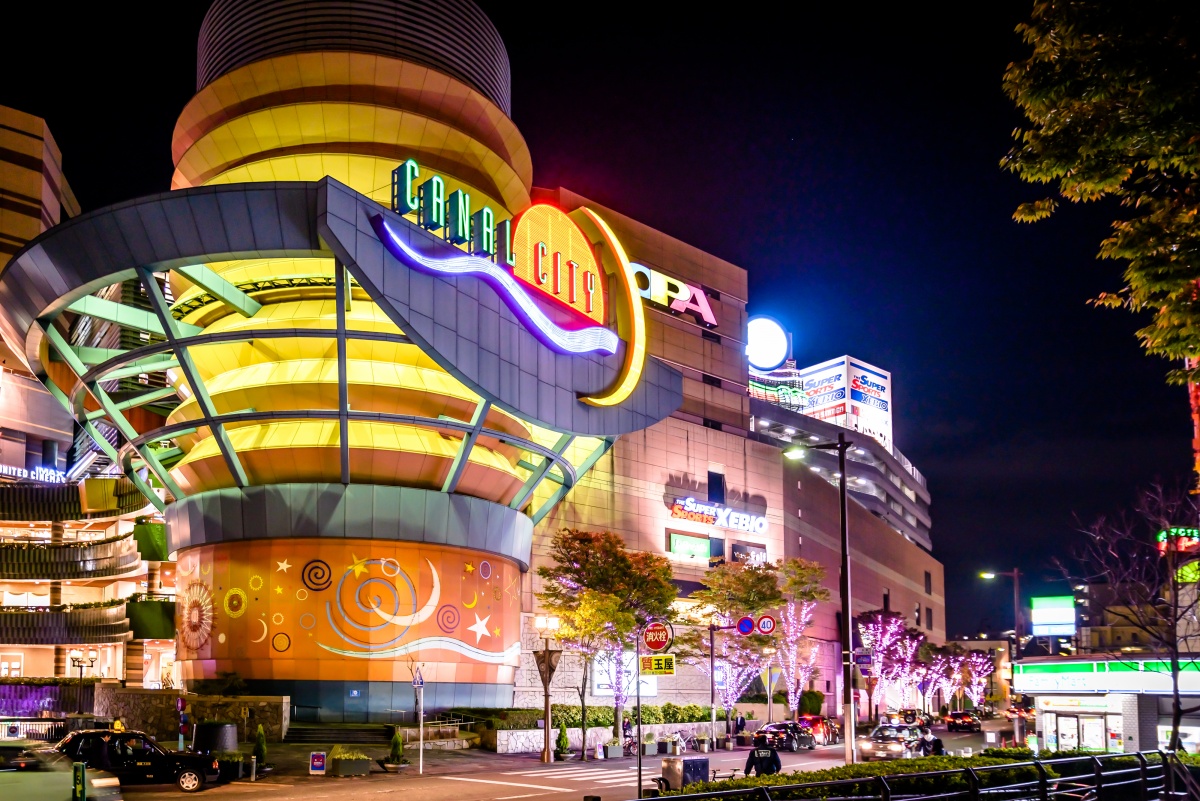
https://www.shutterstock.com/
Canal City is a state-of-the-art modern shopping complex and one of Hakata's biggest tourist magnets. Established on April 20, 1996, it's as popular for its retail outlets as for its innovative architectural style and dazzling night-time illuminations. Said illuminations decorate the eponymous 18-meter-long canal that runs through the complex.
Wandering along the terraces of Canal City while snapping a few photos is common practice for visitors, but the building boasts more than its fair share of entertainment outlets too. The shopping mall is accompanied by a cinema, a theater and an arcade, and the canal often acts as the stage for live musical performances that work in coordination with the evening light shows.
TeamLab, the digital art collective have become a quintessential part of contemporary Japanese art, also have a permanent installation at Canal City—Future Park. The exhibition contains nine future-themed attractions and is only ¥1,200 (about US$10) for a 1-day pass. It's a lot of fun, but is worth noting that this TeamLab project is a little more child-focused than many of their other exhibitions.
Address: 1-2 Sumiyoshi, Hakata-ku, Fukuoka 812-0018
3. Ohori Park
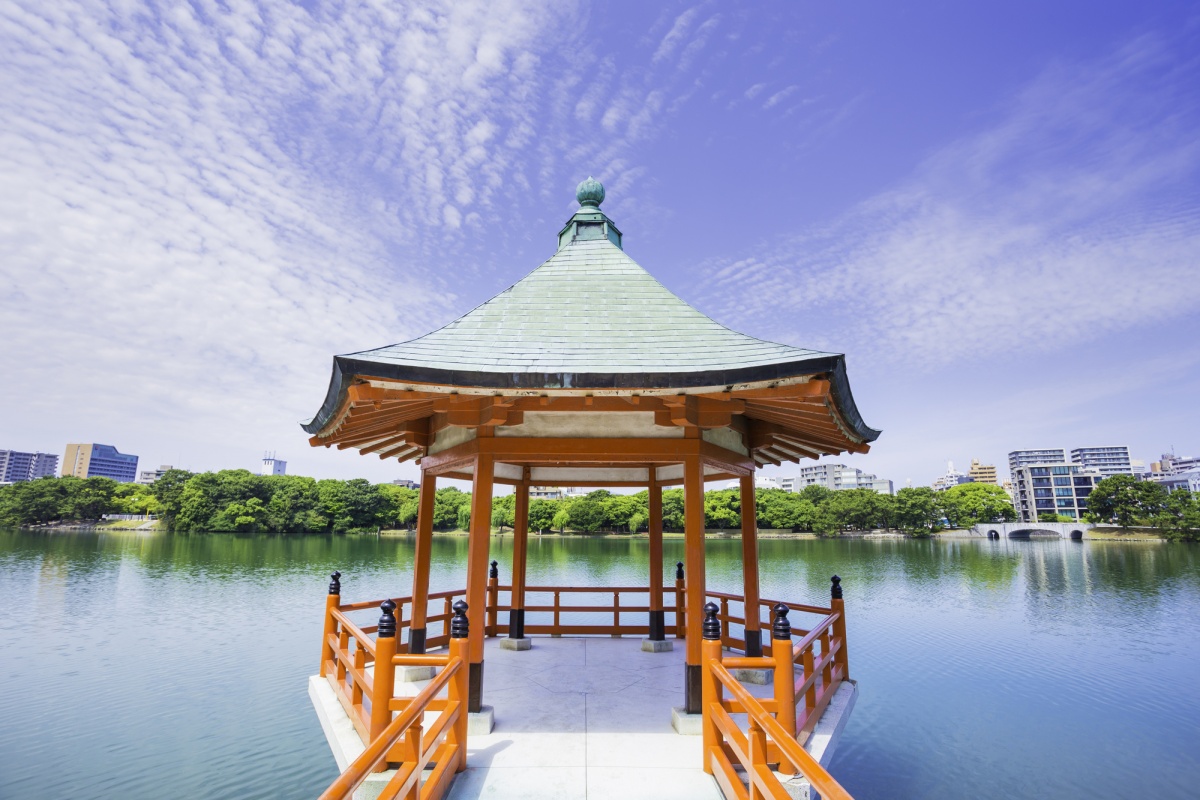
https://pixta.jp/
Ohori Park is a wonderful inner city park; huge open green spaces, a large and pristine central pond, charming traditional architecture, and a neighboring park (Maizuru Park) that contains what remains of Fukuoka Castle. On a nice day in Fukuoka there's no better place to spend a few hours basking in the sunshine than the area around Ohori Park.
In the days when Fukuoka Castle was in its prime, Ohori Park area was used to house feudal soldiers. Over the years as the castle fell into disrepair and the era of feudalism came to an end the area was all but abandoned. Eventually in 1925 park construction plans were drawn up under the tutelage of Tokyo Imperial University Professor Honda Seiroku (who was also responsible for the design of Tokyo's Hibiya Park). Four years later in 1929 the new park was officially opened to the public.
Today Ohori's biggest draw is the area surrounding the main pond. Here you can feed the ravenously hungry local ducks, go for a leisurely stroll across the stone bridges that connect the pond's picturesque islets, take in the scenery from the water's edge at a local café or recline in a swan boat while catching some mid-afternoon rays. If you're still hungry for more actvities the park is also the location of the Fukuoka Museum of Art, the Ohori Park Theater of Noh and the fairytale-like Japanese Garden.
While there's no wrong season to visit, spring might be the best time, when the area is covered in gorgeous cherry blossoms. You don't want to miss it!
Address:1-2 Ohorikoen, Chuo-ku, Chuo 810-0051
2. Kushida Shrine
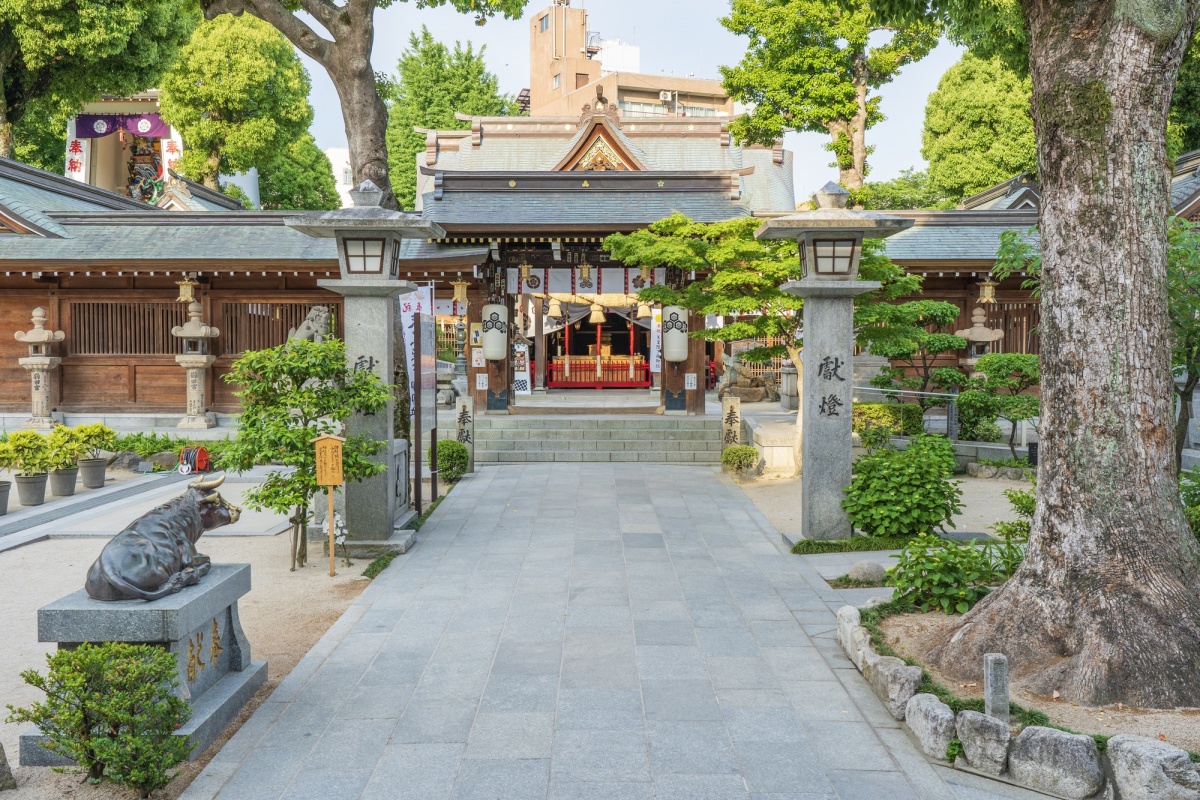
https://pixta.jp/
Like all Japanese cities, Fukuoka has plenty of shrines and temples to enjoy. The finest example of these may well be Kushida Shrine (櫛田神社・kushida jinja) located in Hakata Ward on the Naka River's eastern side. If other areas of Fukuoka represent its modern flair, Kushida Shrine is a striking symbol of its ancient past.
Kushida Shrine is said to have been originally constructed in 757 AD in honor of the deities Amaterasu and Susanoo. However the shrine shared a similar fate to much of Fukuoka's architecture over the proceeding millenium, and was destroyed in a conflagration during a battle in the years prior to reunification. Thanks to the samurai Toyotomi Hideyoshi and his plans to rebuild the area of Hakata, it was resurrected in the year 1587. It is this resurrection of the shrine that we can still see today.
Kushida Shrine also notably plays host to the annual Hakata Gion Yamakasa Festival (which takes place over two weeks in early July), and in winter it is the home of Japan's largest otabuku theatrical mask (pictured above). The mask—which is in the shape of a pale, pudgy, rosy-cheeked woman—is said to bring luck when you walk through her gaping mouth.
Address: 1-41, Kamikawabata-machi, Hakata-ku, 812-0026
1. Tenjin
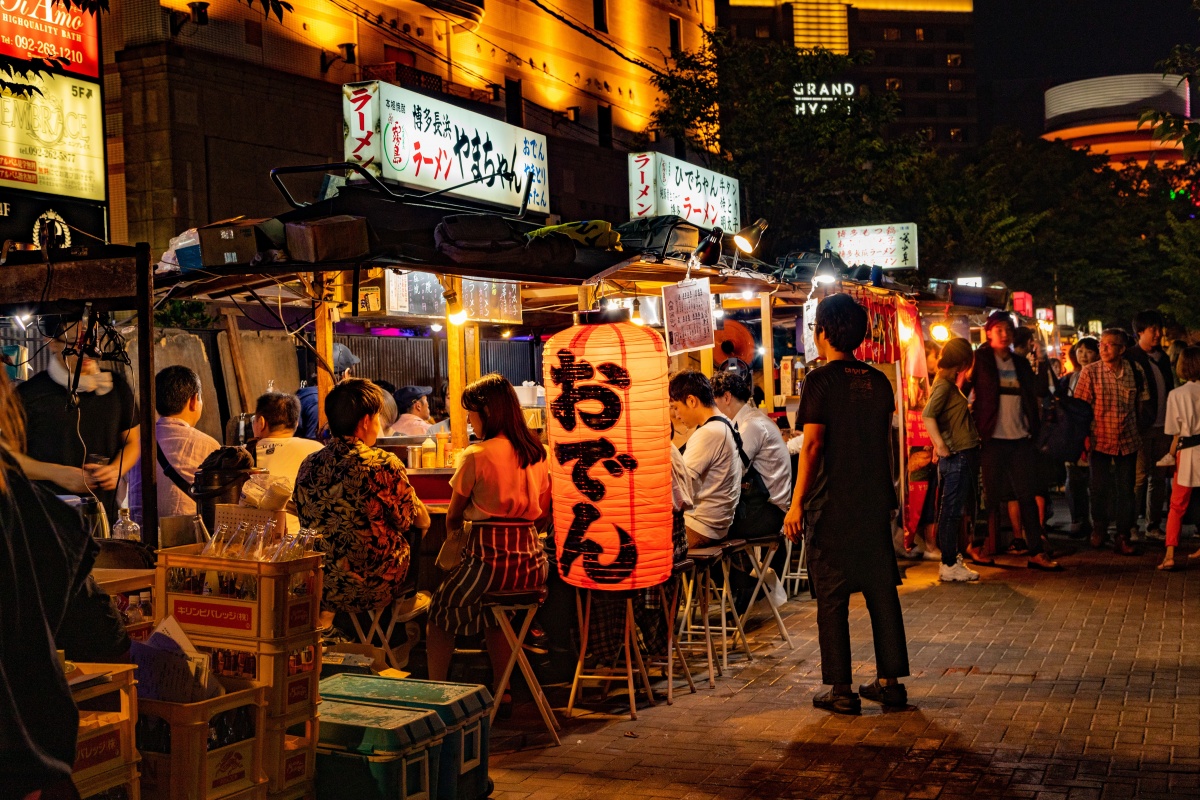
https://www.shutterstock.com/
Tenjin is a pretty good area to start exploring Fukuoka. Located in Fukuoka's Chuo Ward this is the city's epicenter of food, entertainment, nightlife, fashion and retail. Given the area's popularity there's a good chance that your accommodation will be here, so you'll probably have lots of stuff to do right on your doorstep! The main thoroughfares are bursting with retail outlets selling everything from chic fashion to local sake and artisanal souvenirs. The side streets are dominated by classy cafés, bustling ramen shops and vintage stores. If you want to sample some of Kyushu's culinary favorites, have a wild night out on the town, indulge in retail therapy or just get a feel of modern-day Fukuoka then look no further than the Tenjin area.
Some recommendations;
ACROS Fukuoka: This building is iconic for its glass paneled facade which is juxtaposed against a slanted roof covered in dense green foliage. It looks not unlike a futuristic take on the Hanging Gardens of Babylon. It's a multipurpose building that's most famously the home of Fukuoka's symphony hall.
Address: 1-1-1 Tenjin, Chuo-ku, 810-0001, Kyushu
Mitsukoshi Fukuoka: This is one of the city's most famous buildings and is easily recognisable for the giant red Mitsukoshi lettering that's plastered across the front. There's a department store on the 11th floor and an top-drawer food court in the basement.
Address: 2-1-1 Tenjin, Chuo-ku, B2F Fukuoka Mitsukoshi, Fukuoka 810-0001
Oyafuko-dori: The literal translation of this is "disrespectful child street. Why? Because this is Fukuoka's party central! Although the area is popular among students and younger clientele, there's plenty of spots that accommodate patrons of all walks of life!
Address: Tenjin, Chuo-ku, Fukuoka 810-0001
Off the Beaten Track in Fukuoka
For those who want to veer slightly off the beaten track, never fear, we've got you covered!
Dazaifu Tenmangu Shrine
Dazaifu Tenmangu (太宰府天満宮) is a shrine of special significance in Fukuoka, said to be the burial site of adored statesman, scholar and poet Sugawara no Michizane—the man to whom all Tenmangu shrines are dedicated. He was even posthumously bestowed with the accolade of the god of learning, literature and calligraphy.
In life Michizane was a prolific poet, and many of his verses were inspired by the beauty of ume ("plum") trees. There is a splendid ume tree on the grounds of Dazaifu paying homage to one of the scholar's foremost loves. The tree called Tobiume was said to have uprooted and vanished from its original home in Kyoto only to reappear in Dazaifu, following Michizane after he was exiled from the ancient capital.
The original shrine was built in 919 AD, although due to wars that ravaged most of the country it followed the suit of many other shrines by being incinerated in a fire. The 12-kilometer complex at Dazaifu which has been iterated upon over the last 1,000 years or so is awash with plum and camphor trees, various statues of creatures both real and mythological and towering sculptures of Buddhist guardsmen. The honden ("main shrine") was built back in 1591 and stands proudly in the middle of the complex, its red wooden structure intricately decorated by ornate green and gold carvings and an elaborate iconostasis located within.
Address: 4-7-1, Saifu, Dazaifu, Fukuoka 818-0195
Todoriki Sakaten Liquor Store
Todoriki Sakaten sells liquor from all over the world, but its real speciality is Japanese sake. In this department it truly excels. I can safely say without hyperbole that this may be one of the best outlets for buying nihonshu in the entire country.
The vintage store is run by second generation owner Wataru Todoriki, whose employees affectionately refer to him as the "winoisseur." The team regularly fly to breweries all over the nation and to date have acquired over 5,000 variations of carefully selected sake. Some of them also possess enough English to help explain the qualities and nuances of each individual brand and variety, so hopefully you can find one that aligns perfectly with your taste preferences.
Address: 2 Chome-2-31 Sanchiku, Hakata Ward, Fukuoka, 812-0887
Nokonoshima Island Park
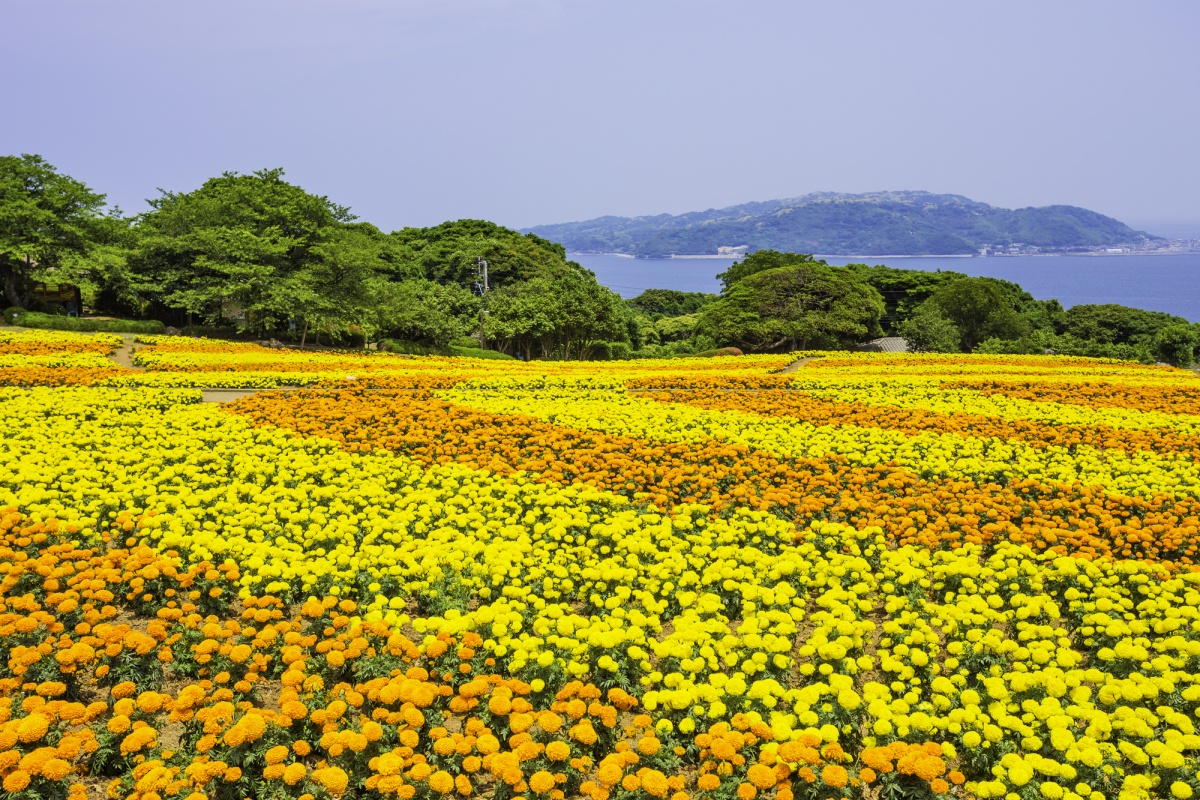
https://pixta.jp/
Nokonoshima Island Park lies just off the northern coast of Fukuoka. It's a flowery outcrop of land located in the waters of Hakata Bay. It's especially popular in spring and summer as the rising temperatures pave the way for a deluge of vibrant flora—daffodils, marigolds, dahlias and more—that carpet the park's plentiful fields. For a full run down on the flowering calendar check here. The island is also very accessible as regular ferries and water taxis leave from Fukuoka's Meinohama area throughout the day.
Nokonoshima is also full of activities. There are picnic areas and BBQ houses, playgrounds and a petting zoo, local restaurants and rental cottages, a sports park and volleyball courts and even a "nokonokoball" course—an area where you can play the island's very own sport!
The park was initially develop in 1979 with the introduction of several small cottages around the flower fields that look back towards Fukuoka. The focus from the beginning revolved around an appreciation of nature. This can even be seen in the islands restaurants where the walls are decorated in watercolor paintings from local artists. There is also an emphasis on keeping technological amenities like internet, televisions and radios to a minimum. Nokonoshima is about enjoying the great outdoors and the picturesque surroundings, freeing oneself from the shackles of technological modernity.
Address: Nishi-ku, Fukuoka, 819-0000
Top 5 Must-try Foods
Food is an indelible part of Japanese culture, nationwide. Fukuoka city is no different and the birthplace of some of the most popular dishes to grace the restaurants of the land of the rising sun.
5. Sweets and Treats
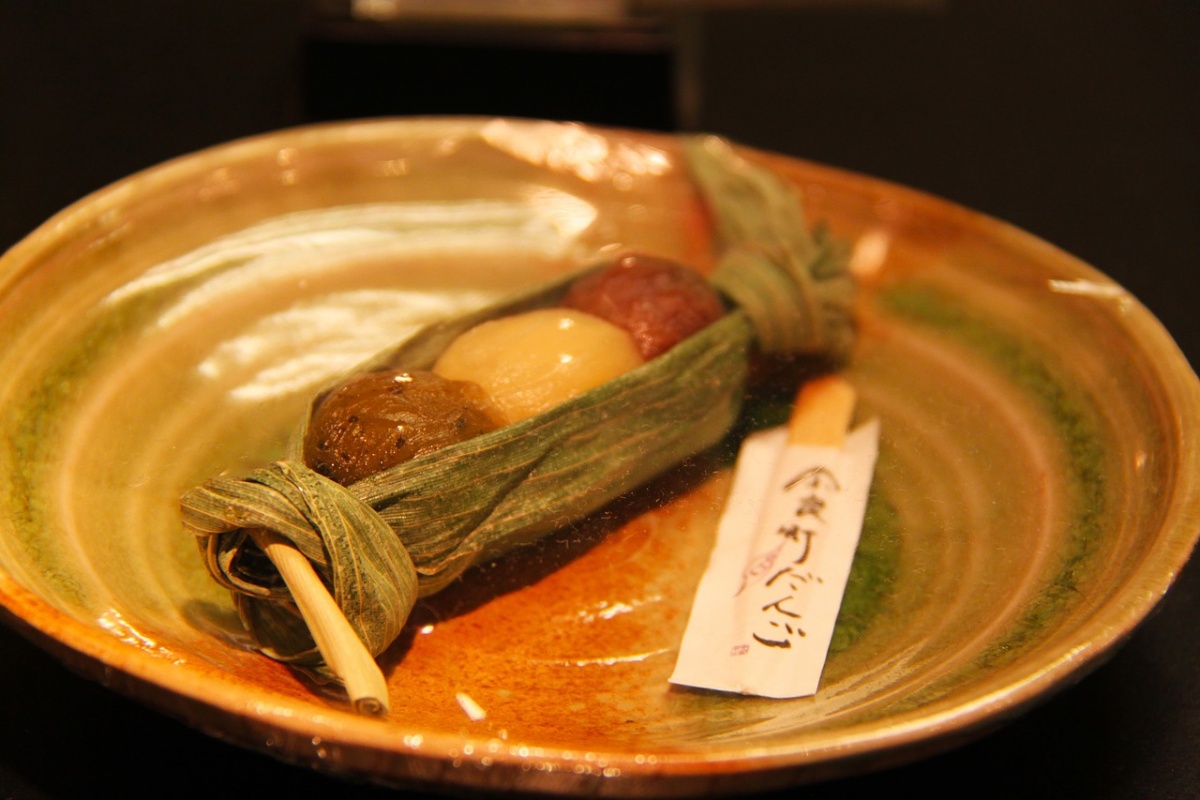
https://pixabay.com/en/desserts-sweets-yummy-delicious-257839/
In Japan culture stipulates that one should give gifts (especially after a holiday or short trip). The word for this kind of gift is omiyage. While omiyage can come in all forms, shapes and sizes the most common type is a box of sweets or biscuits that are local to the prefecture that one has just visited. Fukuoka has a menagerie of these treats and if you're a sweet tooth, some are just too good to be missed.
Keiran Somen are soft-textured noodle-like sweet bundles that're wrapped up in an edible string. In spite of their delectable flavor they are actually made with only eggs and sugar! Super-sweet potato cakes, melon bread with ice cream and local rice crackers are all also common omiyage in Fukuoka. But my personal recommendation is ichigo daifuku, a strawberry that is smothered in sweet bean paste and wrapped in a ball of sweet mochi sticky rice. The Hakata Suzukake Honten store has some of the nicest ichigo daifuku in the city! Address: 12-20 Kamikawabatamachi, Hakata-ku, Fukuoka-shi.
4. Seafood

https://pixta.jp/
Kyushu's relatively warm seawater provides the perfectly temperate climate for over 300 types of edible aquatic creatures (that we know of) to call it home. Many of these fish are caught in the small hours of the night before being almost immediately delivered to Fukuoka's Nagahama Fish Market. The market sits just to the north of Tenjin and offers the freshest seafood to be found in the city, hands down. It may be smaller than the old Tsukiji or new Toyosu markets in Tokyo, but Nagahama is still worth your patronage if your trips coincides with its monthly open-to-the-public-day—the second Saturday of each month. Obviously this is a small window of opportunity but if you miss it, not to worry. Fukuoka is chock-full of reputable seafood eateries that more than likely get their produce from Nagahama!
Here are a couple of our favorites!
Hakata Betendo: This sushi and sashimi store located in chuo-ward is renowned for its local fishy favorites. If you're feeling adventurous be sure to try the seasoned cod roe and innards motsu nabe. If plain old sushi is what your after, they also deliver nigiri and sashimi with quite some expertise.
Address: Fukuoka 2-1-41 Daimyo Chuo-Ku 810-0041
Chiso Yamatoya: Another sushi place but this time there speciality is mackerel! Mackerel is a pretty popular fish worldwide but is actually rather uncommon in Japan. At Chiso Yamatoya they serve a variety of mackerel dishes along with some classic sushi stalwarts.
Address: Fukuoka, 2-6-15 Hakataekihigashi, Hakata-Ku
3. Oden
Oden is one of Japan's great winter-warmer dishes and makes a fine pair with sake. It is often sold at food stalls so Fukuoka has this dish in abundance—particularly in the colder months of the year.
Oden is essentially a light, one-pot stew of boiled eggs, daikon, konjac and possibly fishcakes or tofu in a soy and dashi broth. Unlike heavier dishes—such as ramen—it manages to warm the insides without causing you to loosen a few notches on your belt-buckle! While oden from the yatai stalls is delicious, if you want somewhere that's a little more refined the Niino in the city's Akasaka area is worth a shout.
Address: 2-10-8 Kego Chuo-ku Fukuoka.
2. Yatai Food Stalls

https://www.shutterstock.com/
Yatai (屋台) are small, mobile food stalls that serve local favorites of both the culinary and alcoholic varieties. Fukuoka contains some of the best night-time yatai in the country, many of which align steamy, lamp-lit walkways along the banks of the Naka river. The stalls which usually have seats that are packed into close-quarters around a central cooking area serve Fukuoka classics like ramen, oden, nabe, seafood and various other local and seasonal dishes. Nihonshu and beer tend to be the most popular liquid accompaniments.
Kajishika is one of the best yatai stalls around. It's a family-run business, operated by the young proprietor Kazuyo Shimamura and her father. They serve up an eclectic mix of ramen, local seafood, and seasonal fruit and vegetable skewers—asparagus, kumquats, cherry tomatoes, grapes—wrapped in bacon.
Address: 3, Suzakicho, Hakata-ku, Fukuoka-shi
1. Hakata Ramen
Of course there is a famous local ramen, and this may be the most famous ramen of the all! Hakata ramen (often referred to as tonkotsu elsewhere in Japan) originated in the old city of Hakata before proliferating to all four corners of the country, and well beyond. The dish consists of a thick soup that's made primarily by slow boiling pork bones and other ingredients over a period of several hours. After the broth is ready, egg noodles and toppings of chashu pork, marinated eggs and nori seaweed are added to produce an a rich, umami-filled bowl of soupy-noodle heaven that's just bursting with flavor. Hakata ramen has achieved an iconic status as one of the "three great ramens of Japan."
They say that no one does olive oil like the Italians or Guiness like the Irish, and the same can be said for Fukuoka's mastery of Hakata ramen. Two of the nation's most popular tonkotsu chains—Ippudo and Ichiran—started their humble journeys in Fukuoka before popping up in major cities all over Japan. Both have stores dotted all around Fukuoka and both would be a great place to get your chops around a bowl of Hakata ramen. However, a real favorite with tourists and locals alike is the Ichiran flagship store which sits underneath the company headquarters. The skyscraper which houses the store is decorated from top to bottom in illuminated Ichiran signage. Given its popularity you'll probably have to queue for your food, but it'll be worth the wait! Address: 5-3-2 Nakasu, Hakata-ku, Fukuoka 810-0801.
How to Get Around Fukuoka
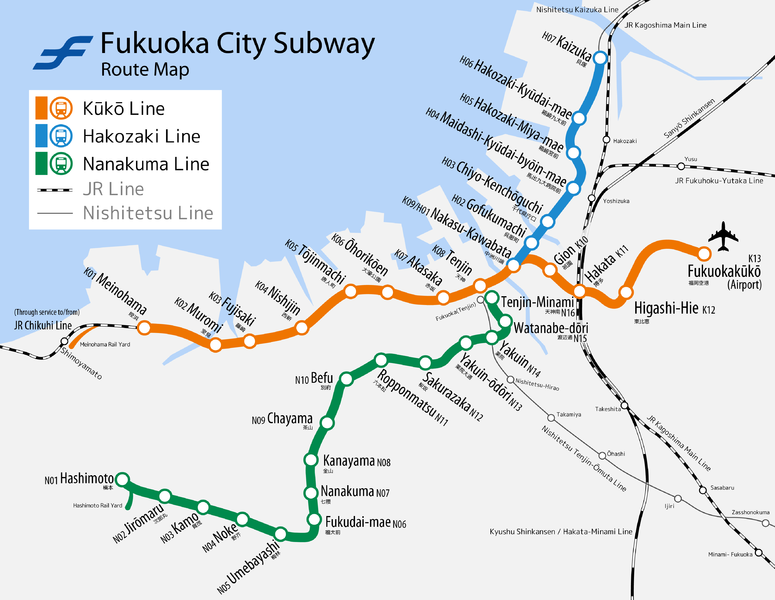
https://upload.wikimedia.org/wikipedia/commons/thumb/a/a3/Fukuoka_city_subway_route_map_EN.png/775px-Fukuoka_city_subway_route_map_EN.png
Subway
The Fukuoka subway system has been in operation since 1981 and is comprised of three main lines—the Kuko, Hakozaki and Nanakuma lines. The Nanakuma and Kuko lines run from the western suburbs through the central city. The short Hakozaki line moves north-eastward from the city centre and only takes 10 minutes to travel from one end to another. All of the lines intersect at Tenjin station, so if you need to change from one to the other then keep yourself awake for this stop! Fukuoka airport is very close to the city and can be easily accessed via the Kuko line. One-day subway passes are ¥620 Monday through Thursday and ¥520 Friday through Sunday.
There are also JR lines which connect Fukuoka to the rest of Kyushu, and the southbound Nishitetsu Line which can be used to access Dazaifu Tenmangu Shrine.
Buses
The Nishitetsu Company also runs the Fukuoka city buses, which are likely to be one of your main modes of transport. There are main stations in Hakata, Tenjin and Fujisaki along with hundreds of other smaller stops along the city's main thoroughfares. There's a ¥100 bus route that loops between Hakata and Tenjin stations passing by Canal City and the yatai food stalls in the process! Although the buses are numbered the bus stops will display information on their electronic timetables in Japanese and English. Buses are very reliable in Fukuoka although using your favorite mobile map app is always recommended just to make sure you know which number your getting.
Tourist Passes
One-day tourist passes are available which give you unlimited access to all buses and trains in Fukuoka's transport network. The tickets are ¥820 for adults and ¥410 for a child (although that does not include access to the Nishitetsu train). In the event that you need to use this single trip journeys are probably more appropriate—from Tenjin Nishitetsu station to Dazaifu Tenmangu would cost only ¥340.
Walking & Biking
Although surrounded by mountains, Fukuoka city's landscape is actually very flat. If the weather is on your side the don't miss out on the chance to explore the city on foot. In spite of its relatively sprawling size it is very pedestrian friendly with open green spaces and spacious sidewalks. This naturally lends itself to cycling as well, so if your feeling active you can combine it with some informative sightseeing in this Fukuoka bike tour!
How to Get to Fukuoka
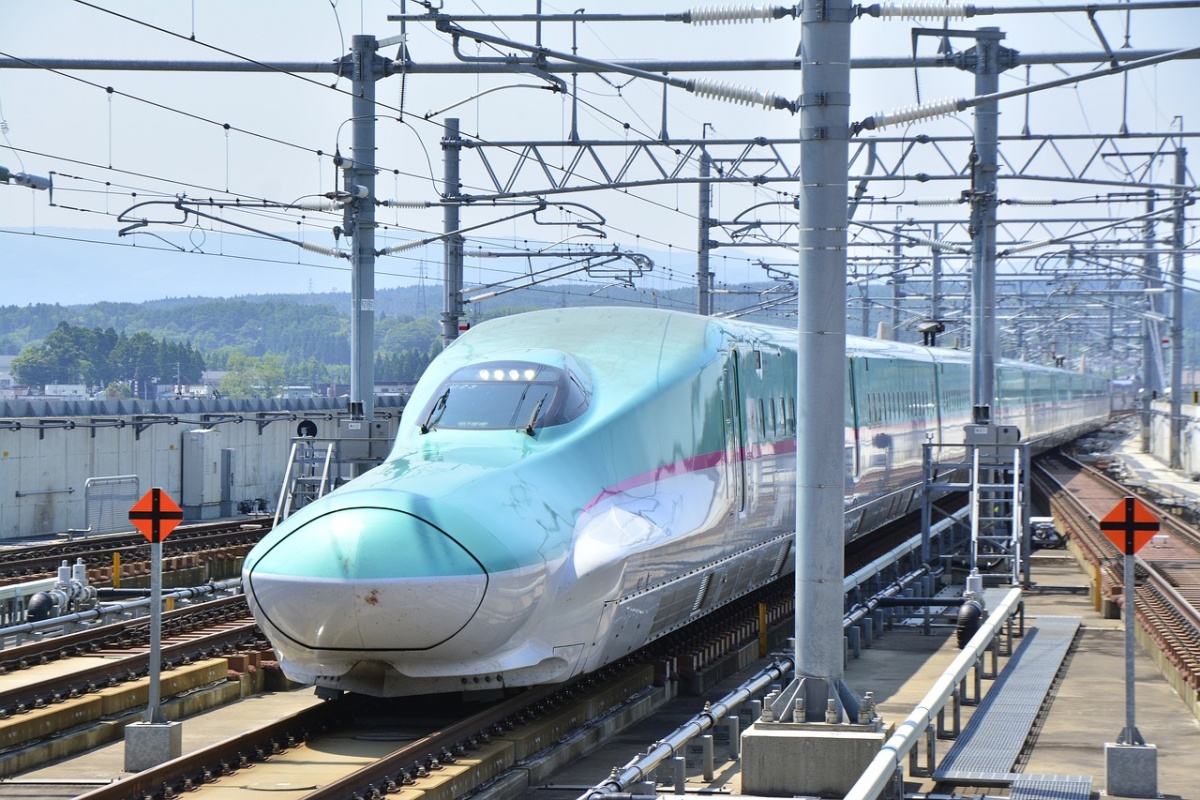
https://pixabay.com/en/shinkansen-trains-japan-japanese-2504783/
By Train
Japan's shinkansen (bullet train) system is incredibly efficient and interconnected. Fukuoka can be reached from as far east as Tokyo via the Tokaido and Sanyo lines. The direct Nozomi train will take around 5 hours and costs ¥23,000 (around $208). If you are a holder of a Japan Rail Pass you have to get a Hikari or Sakura train, the journey will be around six hours and requires a change at Shin-Osaka Station.
By Plane
Fukuoka airport is one of the most conveniently placed airports in the world at only 3.4 kilometers (about 17 minutes by train) from Hakata Station. It serves as one of Kyushu's major ports of entry that has frequent daily flights to all of Japan's major cities. From Tokyo a flight will typically cost between ¥7,000 and ¥15,000 so it is considerably cheaper and (of course) faster than taking the shinkansen. International flights are also available but are restricted to countries like China and Korea due to their close proximity to the island of Kyushu.
By Boat
If you're more a seafarer—and if you've got plenty of time on your hands—then why not try the Ocean Tokyu Ferry? This route starts in Odaiba, Tokyo and finishes in the port of Kitakyushu just to the east of Fukuoka. The journey will take around 34 hours and costs ¥16,000. International ferries are also available from Busan in South Korea.
Fukuoka Local Tips
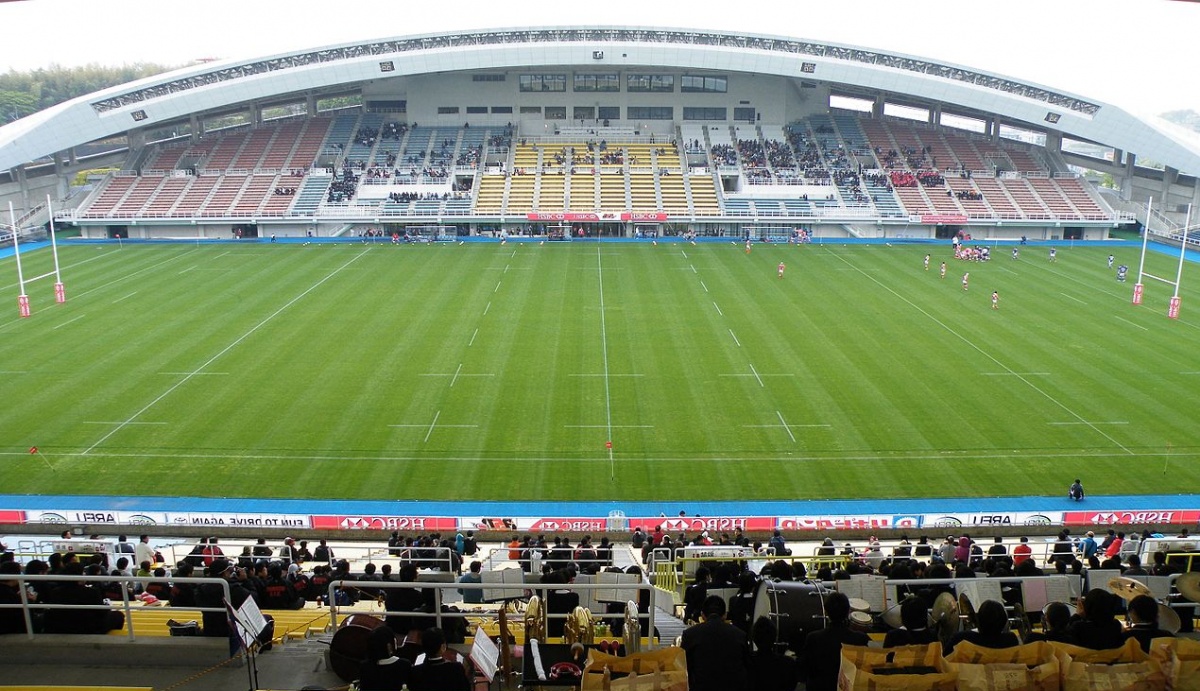
Here's some local tips that are worth bearing in mind when your out and about in Fukuoka;
1. In the warmer months of the year Fukuoka's hiking trails are highly recommended. The city is surrounded by mountains many of which can be summited in several hours. Aburayama and Mount Houmanzan both provide stunning vistas from their peaks. The latter of these can be done with an official tour group.
2. The Rugby World Cup is coming to Japan in 2019 and Fukuoka is one of the cities which will play host to the tournament. The Level 5 stadium located in Hakata ward's Higashi Hirao Park will welcome several nations to the playing field over the six-week showcase. If your trip is in the autumn then keep an eye out to see if it coincides with one of these games!
Fukuoka is also coming down with vintage clothing stores. If you love a good "wavy" shirt or retro track suit from the colorful 90's then you will be spoilt for choice here. Wandering the side streets of Tenjin is a great way to find snazzy clothing for seriously good prices!


